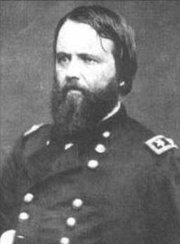John Pope (military officer)
|
|
John Pope (March 18, 1822 – September 23, 1892) was a career Army officer and general in the American Civil War.
Pope was born at Louisville, Kentucky, the son of Nathaniel Pope, a prominent figure in early Illinois Territory. He graduated from the United States Military Academy in 1842, and joined the Topographical Engineers. After serving in Florida and helping survey the northeastern boundary line between the United States and Canada, he fought in the Battle of Monterrey and Battle of Buena Vista during the Mexican-American War.
Soon after the beginning of the Civil War he was appointed Brigadier General of Volunteers. He served as mustering officer at Chicago and then under the command of Maj. Gen. John C. Frémont, Pope assumed command of the District of North and Central Missouri, with operational control along a portion the Mississippi River, and forced the Confederates to retreat southward. Under the command of Maj. Gen. Henry W. Halleck, he cooperated with Flag Officer Andrew H. Foote in taking New Madrid, Missouri, and Island No. 10 in the advance on Memphis. Subsequently he commanded the Army of the Mississippi during the siege of Corinth, winning a promotion to Major General.
After the collapse of Maj. Gen. George B. McClellan's Peninsula Campaign in 1862, Pope headed the newly formed Army of Virginia. He brought an attitude of self assurance that was offensive to the eastern soldiers under his command. He issued an astonishing message to his new army on July 14, 1862, that included the following:
- Let us understand each other. I have come to you from the West, where we have always seen the backs of our enemies; from an army whose business it has been to seek the adversary and to beat him when he was found; whose policy has been attack and not defense. In but one instance has the enemy been able to place our Western armies in defensive attitude. I presume that I have been called here to pursue the same system and to lead you against the enemy. It is my purpose to do so, and that speedily. I am sure you long for an opportunity to win the distinction you are capable of achieving. That opportunity I shall endeavor to give you. Meantime I desire you to dismiss from your minds certain phrases, which I am sorry to find so much in vogue amongst you. I hear constantly of "taking strong positions and holding them," of "lines of retreat," and of "bases of supplies." Let us discard such ideas. The strongest position a soldier should desire to occupy is one from which he can most easily advance against the enemy. Let us study the probable lines of retreat of our opponents, and leave our own to take care of themselves. Let us look before us, and not behind. Success and glory are in the advance, disaster and shame lurk in the rear. Let us act on this understanding, and it is safe to predict that your banners shall be inscribed with many a glorious deed and that your names will be dear to your countrymen forever.
Despite this bravado, Pope was defeated in the Battle of Cedar Mountain and the Second Battle of Bull Run. He was relieved of command in September 1862 and his army was merged into the Army of the Potomac. He spent the remainder of the war in the Department of the Northwest in Minnesota, dealing with the Sioux Uprising.
Following the Civil War, General Pope served with distinction in the Indian Wars. He retired in 1886 and died at the Ohio Soldiers' Home near Sandusky, Ohio.

